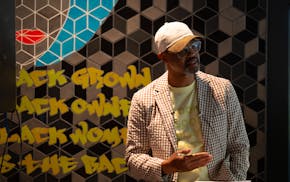At this time two years ago, Target had just ended in-store mask requirements, and executives were upbeat as they revived their spring tradition of flying to New York to meet investment analysts.
The rocket-like growth Target experienced during the pandemic had ended, but they were confident it would grow faster than it did in the last decade.
Within a month, they realized they'd made a big mistake. Freed of pandemic-era restrictions, American consumers were shifting their spending away from products and to restaurants, travel and other experiences. Target had too many goods in stores and warehouses.
What followed were the two hardest years for CEO Brian Cornell since the period immediately after his 2014 arrival, when Target was in crisis over a botched expansion to Canada.
Sales growth slowed sharply in 2022, then fell last year for the first time since 2016. Profits collapsed in 2022, then recovered last year as inventory shrank and costs were slashed. Target's shares are about 25% less valuable than in March 2022.
On Tuesday, as Cornell and other Target executives held this year's meeting with analysts, they signaled another new start. "Having tackled both industry and in-house challenges the last couple of years, I can tell you I'm not satisfied," Cornell said.
"Our team is not satisfied with our recent top-line results," he added, referring to sales. "We wanted to be even farther along than we are today, but we're confident in our path forward."
Target will soon add a paid membership option to its Circle customer loyalty program, making it more like Amazon Prime. It expects to add 300, mostly full-size, stores over the next decade. That's more than the 166 it has added since Cornell's arrival, reaching 1,956 in 2023.
One reason Target hasn't needed as many new stores in recent years is that per-store revenue was growing from e-commerce. But there are physical limits to serving in-store and drive-up customers while also shipping digital orders from stores.
"If you had told me five years ago these are the volumes that Walmart and Target are putting through their stores today, I would have said that's not possible," said Ed Yruma, retail analyst at Piper Sandler, the Minneapolis-based investment bank. "They've both done extraordinary jobs at getting more volume through a store. There's just this recognition there are physics to it."
Tuesday marked another milestone at Target. For the first time, all the presenters to analysts were people promoted into the C-suite by Cornell. The last two leaders who were in Target's top ranks when he arrived have recently left — John Mulligan, chief financial officer when Cornell arrived and chief operating officer since 2015, and Laysha Ward, who was the face of Target in the philanthropic world for more than two decades.
Twin Cities residents tend to view Target possessively. The company is a descendant of Dayton's, which shaped retailing and fashion in Minnesota for much of the 20th century. The firm's founding family became one of Minnesota's richest and it continues to influence the region's civic and political scene to this day.
Cornell was the first CEO who hadn't worked at Target before leading it. Now, he has led it longer than anyone but Bob Ulrich, whose 24-year tenure spanned its rise into one of the nation's largest retailers.
Ulrich began his career as a merchandiser at Dayton's in 1967. He took charge of the Target unit in 1984, when it had just over 200 stores. The 1980s and 1990s were golden years of fast expansion, mirroring the growth of America's suburbs and the baby boomer generation's wealth. Target had 400 stores by 1990 and reached 1,000 in 2001.
Ulrich introduced the "Expect More Pay Less" brand promise in 1994 as a way to distinguish Target from main rival Walmart. By the early 2000s, Target's growing partnerships with fashion designers and celebrities also helped it stand out. At Ulrich's retirement at the start of 2008, Target had nearly 1,600 stores.
His successor Gregg Steinhafel, who began his Target career in 1979 as a buyer in its paint department, took charge at a tough moment. The U.S. was heading into a prolonged recession and activist investor Bill Ackman was seeking a place on the Target board.
The pace of Target's expansion slowed from 90 stores in 2007 to 60 in 2008 and as few as 10 in subsequent years. Having blanketed the U.S., Target looked to Canada for growth. Steinhafel agreed to a bold plan to build out 120 stores across Canada in 2013, the most Target had ever opened in one year. The move would prove to be the costliest mistake in the company's history and, in early 2014, the Target board fired Steinhafel.
Cornell, who had led the Sam's Club unit at Walmart, Michaels Stores and a food unit at PepsiCo, reversed the expansion into Canada almost immediately. In March 2015, he took another step everyone expected — a layoff of 1,700 people at headquarters, the most in Target history.
More importantly, he grew revenue with surgical improvements, such as revamping its private labels, rather than adding lots of stores. Target also steadily built up e-commerce capabilities. When the pandemic arrived, Target was deemed an essential business freed of government shutdown orders.
As Americans hunkered down, they spent heavily on staple items and household goods. Target's annual revenue, which had hovered around $70 billion for much of the 2010s, soared past $90 billion in 2020 and $100 billion in 2021.
By mastering the fulfillment of digital orders from stores, the company became very efficient with existing space. Sales per square foot leapt from the $300 level for much of the 2010s to around $440 today.
When the change in consumer spending happened as the pandemic eased, however, Target stumbled. Only three weeks after the 2022 investor meeting, Cornell announced it would slash prices and slow orders to eliminate the bloat. Since then, Target hasn't been able to grow sales and profits simultaneously.
And that's what Cornell wants. "Our goal is to recapture profit and sales, traffic and market share gains," he said Tuesday.

Ramstad: Gov. Walz, things are not getting done in Minnesota

Ramstad: AI is English-centric, but it's picking up Hmong quickly

Ramstad: Minneapolis' Camden neighborhood is rising. Houston White wants to keep it that way.

Ramstad: Minnesota's big businesses are in crisis with a common problem

